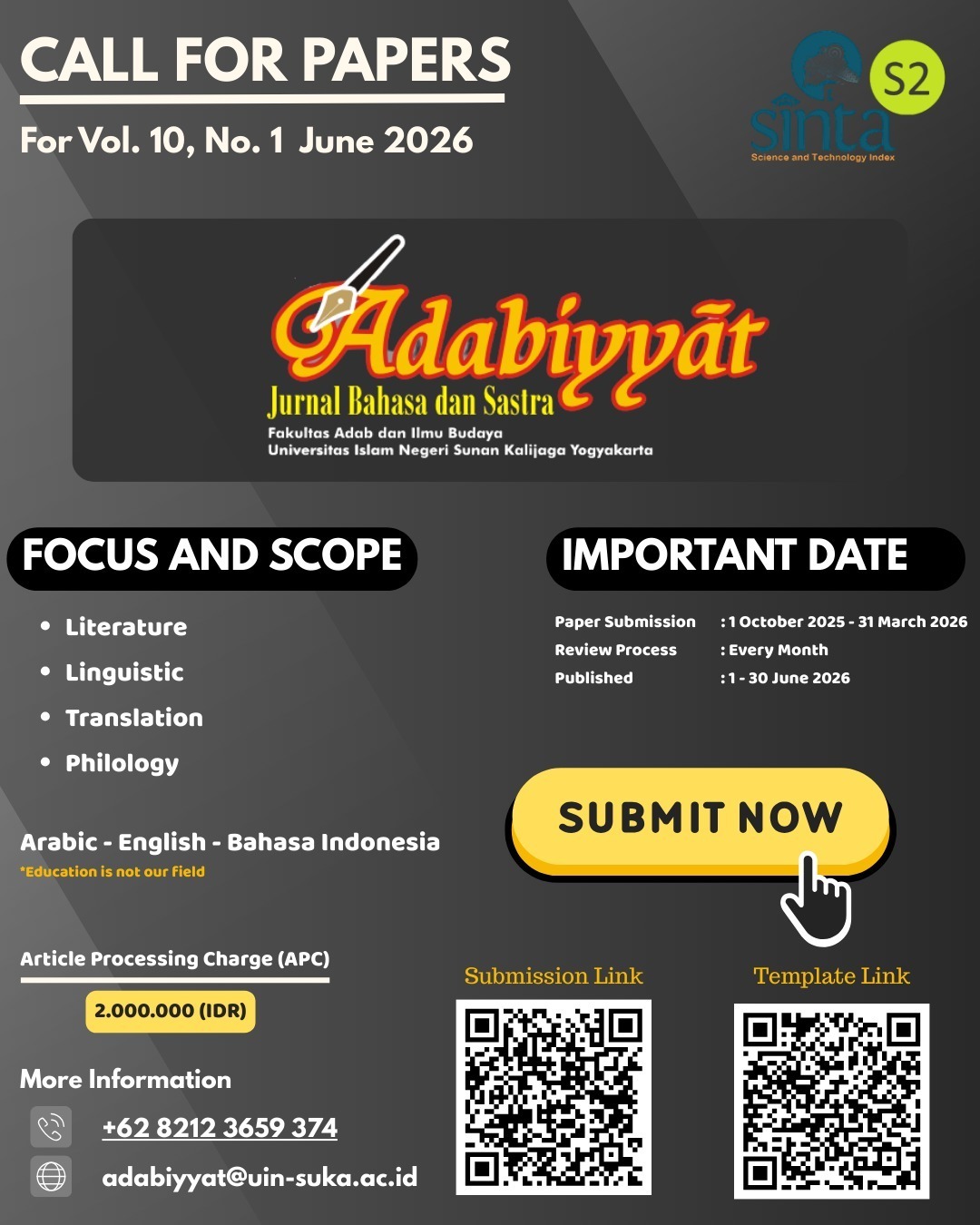TEKNIK DAN FUNGSI PENERJEMAHAN KATA UMPATAN PADA NOVEL RIḤLAH ILĀ ALLĀH
DOI:
https://doi.org/10.14421/ajbs.2023.07012Keywords:
swear words, translation techniques, swear functionAbstract
This study aims to find out the translation techniques of swear words in the novel Riḥlah ilā Allāh by Najib Kaelani and the function of those swear words. The data in this study are in the form of swear words and their translations which are sourced from the novel Riḥlah ilā Allāh and its translation "Meniti Jalan Allah". The used theory for this research is the translation techniques from Molina & Albir’s perspectives, and Swear words functions by Trudgill & Andersson. This research is descriptive and qualitative with the data collection method using the reading and note-taking method. Furthermore, the data analysis technique starts by grouping the data, looking for the techniques used in translating swear words, then determining the function of the swear words that have been collected. The results showed that the swear words in the novel Riḥlah ilā Allāh by Najib Kailani were translated using eight techniques, and have three functions, namely expletive, abusive, and auxiliary.
Downloads
References
Baker, Mona. 2017. In Other Words: A Coursebook on Translation. Edisi Ketiga. Abingdon, Oxon ; New York, NY: Routledge.
Bessie, Polce Aryanto. 2017. Metode Penelitian Linguistik Terjemahan. Jakarta Barat: PT. Indeks.
Galingging, Yusniaty, dan Gunawan Tambunsaribu. 2021. “Penerjemahan Idiomatis Peter Newmark dan Mildred Larson.” Dialektika: Jurnal Bahasa, Sastra dan Budaya 8 (1): 56–70. https://doi.org/10.33541/dia.v8i1.3112.
Hartono, Rudi. 2017. Pengantar Ilmu Menerjemah (Teori dan Praktek Penerjemahan). Semarang: Cipta Prima Nusantara.
Kaelani, Najib. 2004. Riḥlah ilā Allāh: Meniti Jalan Allah. Diterjemahkan oleh Ahda Bina Afianto dan Habiburahman El-Shirazi. Edisi Pertama. Solo: Era Publishing.
———. 2005. Riḥlah ilā Allāh: Qissah al-Ikhwān al-Muslimūn al-Dāmiyah. Cetakan 20. Dār al-Shahwah lī al-Nasyr.
Kridalaksana, Harimurti. 2008. Kamus Linguistik. Edisi 4. Jakarta: PT Gramedia Pustaka Utama.
Moeloeng, J. M. 2005. Metode Penelitian Kualitatif. Bandung: Remaja Rosdakarya.
Molina, Lucía, dan Amparo Hurtado Albir. 2004. “Translation Techniques Revisited: A Dynamic and Functionalist Approach.” META 47 (4): 498–512. https://doi.org/10.7202/008033ar.
Munawwir, Ahmad Warson. 1997. Al Munawwir Kamus Arab - Indonesia. Yogyakarta: Pustaka Progressif.
Munday, Jeremy. 2010. Introducing Translation Studies: Theories and Applications. Erscheinungsort nicht ermittelbar: Taylor & Francis.
Nugroho, Andi Bayu. 2011. “Teknik Penerjemahan Wordplay dan Kualitas Terjemahannya dalam Novel Charlie and the Great Glass Elevator karya Roald Dahl.” Surakarta: Universitas Sebelas Maret.
Nurazizah, Ratu Syarifa, dan Usmi Usmi. 2021. “Penerjemahan Makian dalam Webtoon Yakhan Yeongung ke dalam Bahasa Indonesia.” JLA (Jurnal Lingua Applicata) 4 (2): 99-121. https://doi.org/10.22146/jla.58401.
Nurmala, Ima, Syihabuddin Syihabuddin, dan Asep Sopian. 2020. “Studi Analisis Penerjemahan Verba Berpreposisi pada Novel Terjemahan Alfu Laylah wa Lailah Karya Fuad Syaifuddin Nur.” Jurnal Pendidikan Bahasa dan Sastra 19 (1): 131–37. https://doi.org/10.17509/bs_jpbsp.v19i1.20765.
Puruhito, Gregorius Gyan. 2021. “Analisis Teknik Penerjemahan Kata Umpatan pada Subtitle Serial Netflix.” Prosiding Seminar Nasional Linguistik dan Sastra (SEMANTIKS), 10.
Putra, Rachmad Rizky. 2016. “Bentuk dan Fungsi Kata Umpatan pada Komunikasi Informal di Kalangan Siswa SMA Negeri 3 Surabaya: Kajian Sosiolinguistik.” Skripsi, Surabaya: Universitas Airlangga.
Rosikh, Fahrur. 2014. “Eufemisme dan Tabu dalam Bahasa Arab.” Ummul Qura: Jurnal Ilmiah Institut Pesantren Sunan Drajat (INSUD) Lamongan 4 (2). http://ejournal.kopertais4.or.id/pantura/index.php/qura/article/view/2034.
Sari, Ayu Kartika, dan Parwati Hadi Noorsanti. 2017. “Fungsi Kata Umpatan pada Tokoh Sakuragi dalam Serial Televisi Jepang Dragon Zakura” Japanology 6 (1): 105-18.
Sudana, P A P, Suyasa, dan N.P.E. Marsakawati. 2014. “Analisis Penerjemahan Istilah Budaya pada Novel Negeri 5 Menara ke dalam Bahasa Inggris: Kajian Deskriptif Berorientasi Teori Newmark.” Jurnal Ilmu Sosial dan Humaniora 3 (2): 435-45. https://doi.org/10.23887/jish-undiksha.v3i2.4468
Trudgill dan Andersson. 1992. Bad Language. England: Penguin Books.
Utama, Muhammad Apridho Hensa, dan Moh Masrukhi. 2021. “Analisis Teknik Penerjemahan Bahasa Arab ke Bahasa Indonesia dalam Ceramah Habib Umar Bin Hafidz.” Al-Tsaqāfah: Jurnal Ilmiah Peradaban Islam 18 (2): 191-200. https://doi.org/10.15575/al-tsaqafa.v18i2.13184.
Utami, Rika Putri. 2019. “Program Studi Pendidikan Bahasa Indonesia Fakultas Keguruan dan Ilmu Pendidikan Universitas Muhammadiyah Surakarta 2016.”
Downloads
Published
Issue
Section
License
Copyright (c) 2023 Aad Nur Sayyidus Syuhuur Baking, Sajarwa Sajarwa

This work is licensed under a Creative Commons Attribution-ShareAlike 4.0 International License.
- Adabiyyāt: Jurnal Bahasa dan Sastra publishes all articles entirely in full text.
- It is permissible for readers to download and to use it for scientific purposes and scientific dissemination.
- The author can re-publish the article that has been published by the Adabiyyāt: Jurnal Bahasa dan Sastra after obtaining written permission from the editor. This letter can be obtained by submitting a request letter for permission to republish the article to Adabiyyāt: Jurnal Bahasa dan Sastra via email adabiyyat@uin-suka.ac.id. In the second publication, the author is required to include information that the article was firstly published by the Adabiyyāt: Jurnal Bahasa dan Sastra.









